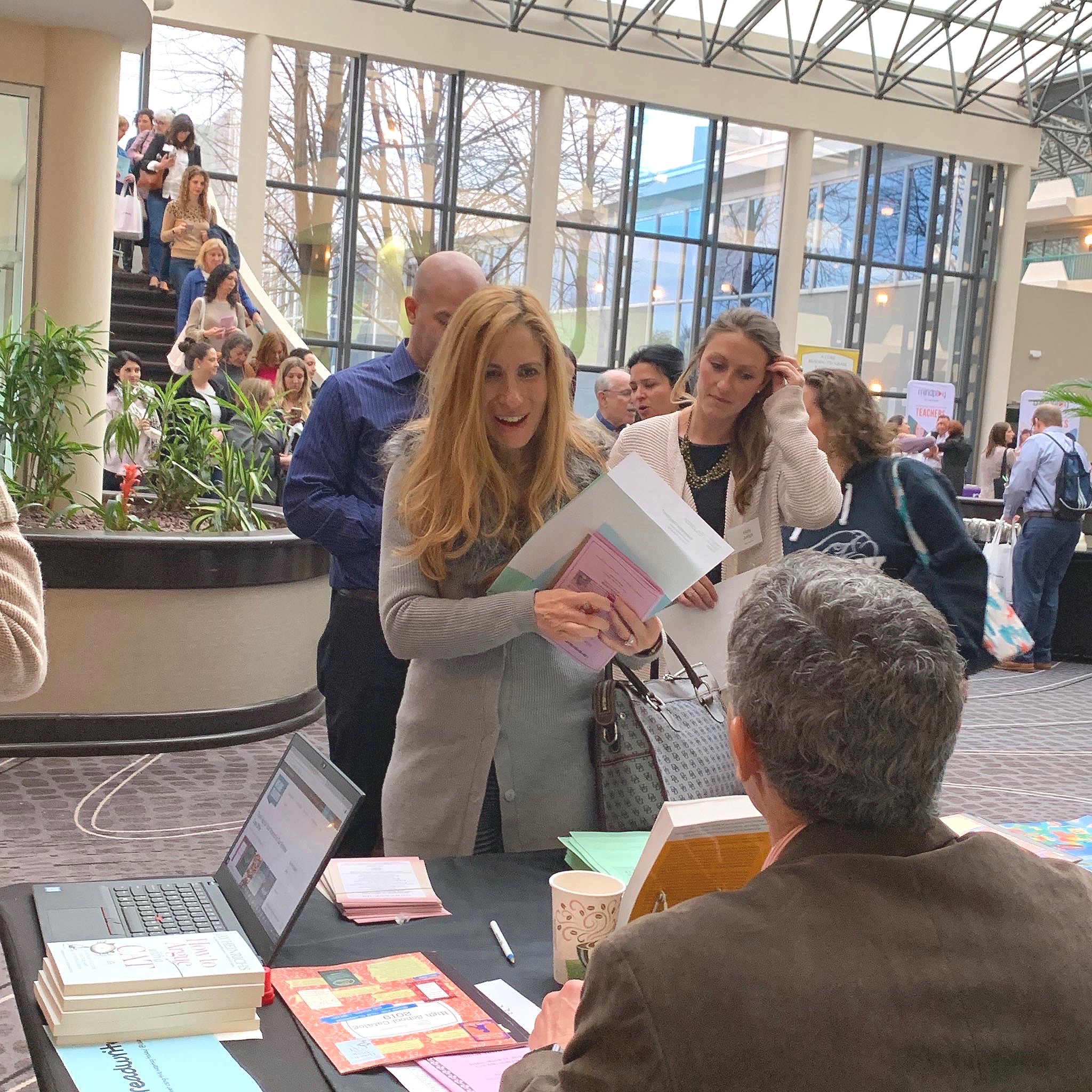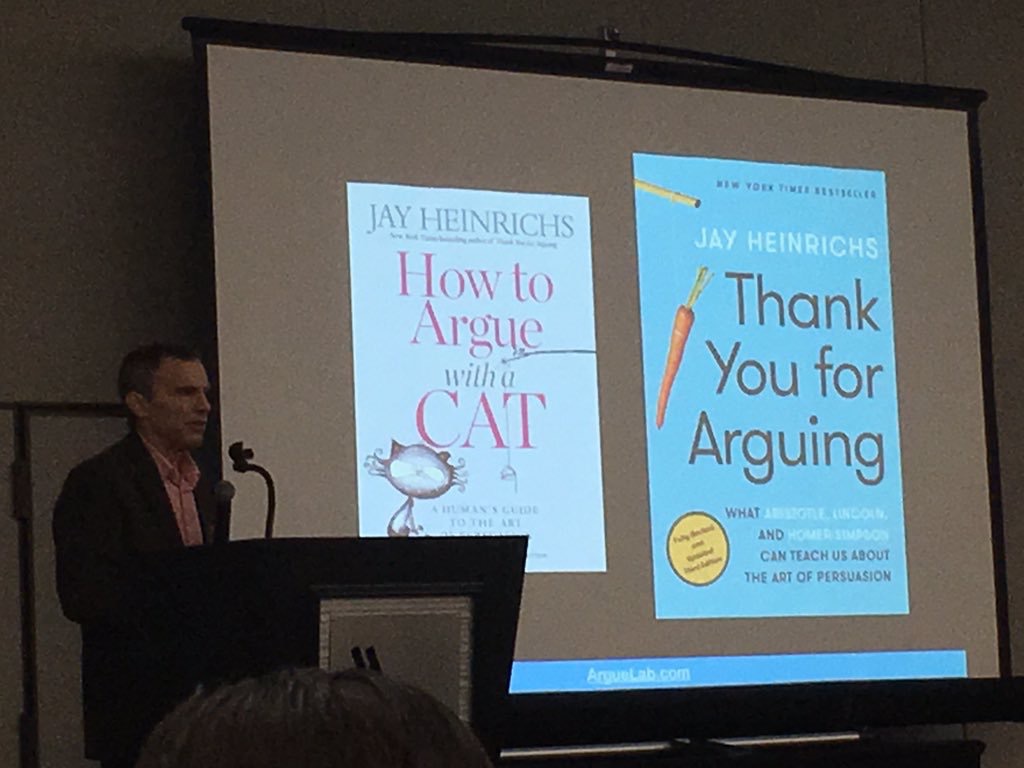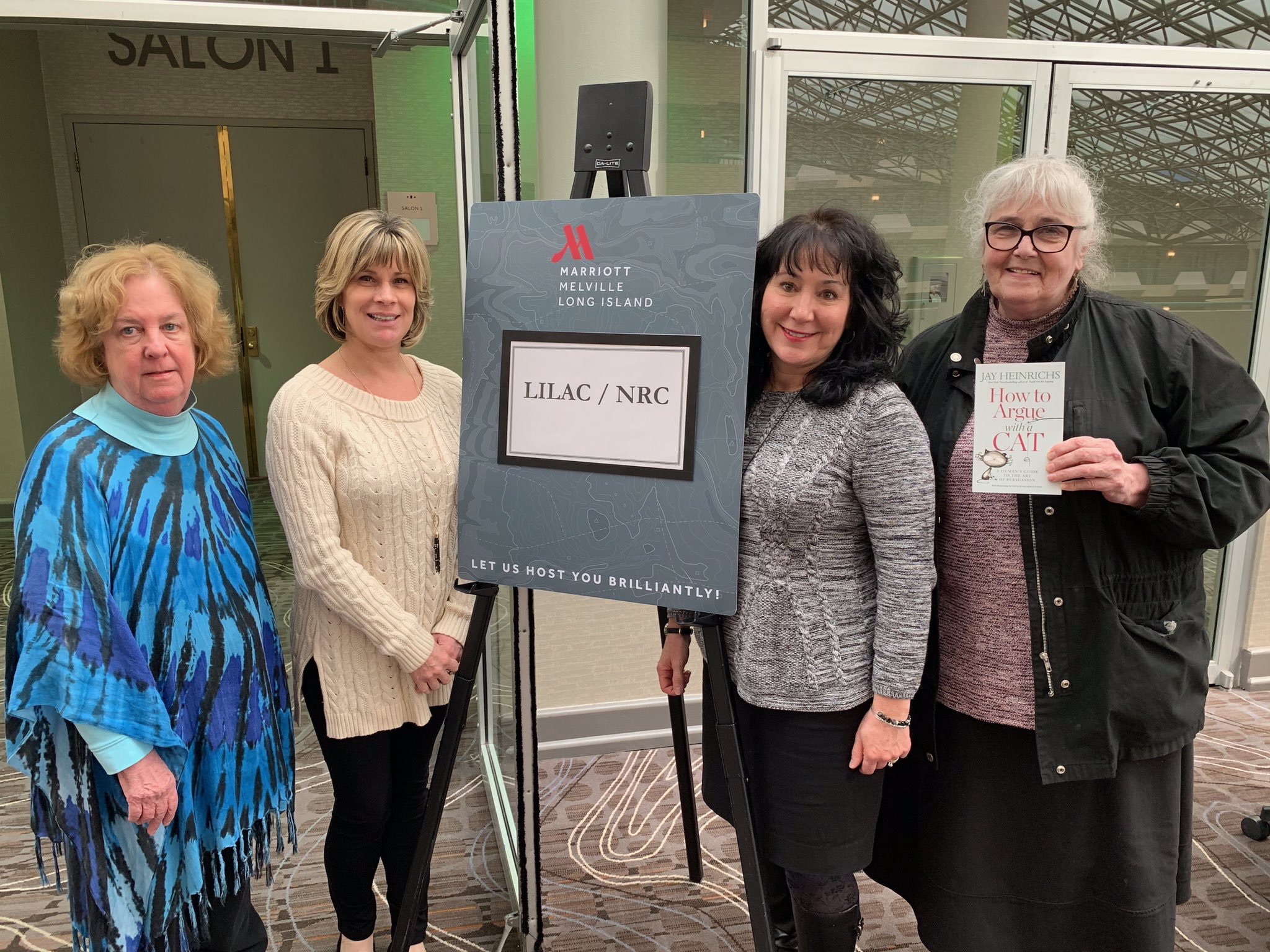Inspiring Collaboration In The Classroom
Jay Heinrichs on Teaching Rhetoric at The Long Island Language Arts Council Teachers' Conference
Jay Heinrichs delivered a fantastic lecture at the Long Island Language Arts Council Teachers’ Conference in March. The queues for “How To Argue With A Cat” stretched over two storeys of the Melville Marriott building as Jay endeavoured to meet each teacher, sign books and answer questions.
There was some great feedback from the teachers during and after the conference too…
“Just read the book—ordered it during Jay’s presentation @LILangArtsCoun annual conference—arrived today. Excellent rhetorical introduction. Can’t wait to use it with our 9th-10th graders.”
“Great learning @LILangArtsCoun #readwrite19 #lis4gifted”
“Finally read How to Argue with a Cat. Some nice ideas I want to use to help my students approach argument better. However, I must sadly report that my cats are still winning all arguments.”
The talk evoked a brilliant response and Jay is looking forward to seeing persuasive skills developing in classrooms- the cat way! Click on the image below to see the teacher’s guide.
We’ve since seen many excited tweets from teachers about the arrival of “How To Argue With A Cat” and its use in the classroom, so we’ll be posting teaching tips and fun exercises to do with students from the teacher’s guide (watch this space). We’d love to see any classroom activities with the book, essays, Skype calls with Jay or your own ideas - we love it all! - so please email us at persuasivecat@gmail.com :), or alternatively, click to contact Jay below.
If you’d like to increase the interactive element of your class, feel free to ask Jay for a class Skype call. Students love this - he can answer all their burning questions - plus he’s a nice guy too!
Due to the great success of Jay’s talk at the LILAC conference for Teachers, I have posted the talk below. Feel free to share, share, share!
Like you, I grew up reading books. I raided the library every week. My mother had to kick me out of the house every day so I’d get some exercise, and of course I’d smuggle reading material. But while I fell in love with The Wind in the Willows and the Narnia books, Huckleberry Finn, At the Back of the North Wind…something bothered me all along. It was like an itch. I thought, words don’t just sit around looking pretty, do they? Words have power. They bring people together, they spark revolutions, they make us laugh and cry, sell junk we don’t need, even get people elected president, for better and worse.
Words have power. But what kind of power? And how do you use them to change the world—to, for instance, bring about social justice?
This question stuck with me for many years, until one day, while wandering through the stacks in the Dartmouth College library, I made a life-changing discovery. I was working at Dartmouth back then, some 20 years ago, and continued my childhood habit of spending ridiculous amounts of time in the library. This one time, I found myself in a part of the stacks I hadn’t visited before. In fact it looked like no one had visited for many years. Half the fluorescent bulbs had burned out, cobwebs all over the place. Clearly, these books hadn’t been checked out in decades.
Out of all those dark and dusty books, one book, bound in red leather, caught my eye. I pulled it down and opened it, and found it had been signed by John Quincy Adams. The book was by Adams himself, a series of lectures he had delivered to first-year students at Harvard in 1805, when Adams was a United States Senator. I stood there and read the first lecture. He told the studentsto “catch from the relics of ancient oratory, those unresisted powers, which mold the minds of men to the will of the speaker, and yield the guidance of the nation to the dominion of the voice.”
Unresisted powers. Can you imagine being one of those adolescent boys at Harvard. “I got to get me some of those powers!” I later researched what happened to each of the students in that class; they included leaders of industry, top diplomats, great authors, and a future president of the United States, besides John Quincy Adams himself.
This was what I’d been looking for ever since I was a kid. Adams was introducing me to rhetoric the art of persuasion, the use of the power of words.
So here I am, a heterosexual white male, talking about unresisted powers. What can go wrong?
But I think those powers are often misunderstood. In the wrong hands, the tools of rhetoric have done terrible things. But in the right hands—your hands—I believe they can do wonders for students…and for you.
Rhetoric teaches a student how to listen strategically, how to read the beliefs, expectations, and values of others, how to understand their emotions, and to use this knowledge to bring people together, to make common decisions. These are powerful things. They’re powers.
Adams’ lectures included a list of books, most of which were right there in that dusty section of the stacks. I spent the next 20 years studying them, interviewing rhetoricians. I learned that every one of the nation’s founders studied rhetoric, and used the art’s principles in writing the Declaration of Independence and the Constitution. Shakespeare studied rhetoric at the Stratford Grammar School. The King James Bible is steeped in rhetoric. Martin Luther King was a keen student of rhetoric.
Why should you care?
Because we live at a time when the very act of reading is under challenge.
I don’t have to tell you that. It’s not just the distractions—the smartphones and videogames. Reading itself is questioned as a discipline. And yet we know how reading develops the kind of mind that correlates with the ideal citizen. In this day and age, how do we turn students into readers? No, I mean…
How do we inspire students to become passionate about reading, and curious about reading the works of people not like themselves?
I have a suggestion. It shouldn’t surprise you that it comes from my study of rhetoric. It has to do with teaching students to harness the power of words in a collaborative way—to see the power in front of them, as a force for good. Rhetoric lets students work together to share ideas, and take their own ideas to a higher level.
So let’s see how. We’ll explore how rhetoric deals with the act of creation. And then we’ll see if we can try a few games that have been proven to work in the classroom. Ultimately, we hope to spark in students the notion that books are more than something that’s good for them. Books contain words, words have power, and that power can be harnessed as the single greatest element that can change the world. I’d to offer a couple suggestions, and then maybe we can play a game.
Suggestion number one:
Creativity is a matter of combination.
Creativity is a matter of combination. Think about it. Most of the world’s great inventions and concepts combined two or more unlike things to make one greater thing.
Take the iPhone. Steve Jobs and his people invented the iPhone by combining a music player with a video player and a telephone and a computer. Other companies were already making smartphones, but he made one that combined the best ideas and made them better.
Was that creative? Was that original? Does it matter? I got an iPhone!
The ancient Greeks and Romans wouldn’t have known what to do with an iPhone any more than my Dad would, but they would have understood the creative process Apple went through. The Romans called it inventio. It’s where we get the word invention. But unlike us moderns, they saw invention as two things:
Creativeness
Discovery
In any act of collaboration, the ancients treated ideas as if they were treasures laid onto a landscape. You didn’t dream things up. You found them. And then you brought those treasures together to make something new and wonderful.
How? Through conversation. Discussion. And, dare I say, argument—the persuasive sharing of different perspectives, different opinions.
Invention comes from the discovery of new things by bringing ideas together. By collaborating.
Suggestion number two:
Teach choices through the tenses.
To see what I’m talking about, let’s go to our Aristotle. He wrote the definitive book on rhetoric, and he defined some ways to have conversations and to collaborate that have relevance for you and me today.
Aristotle defined three kinds of rhetoric. One kind is especially helpful for collaboration. And here’s the important part: Each kind gets assigned to a tense—past, present, or future. It’s critical for students to learn this, I think, as soon as they learn the tenses themselves.
The first kind of rhetoric, forensic, has to do with the past. It’s about forensics, the language of crime and punishment: whodunit, and what kind of detention we’re going to give the kid. Forensic rhetoric is about the past, and it tends to be spoken in the past tense.
Aristotle’s second rhetoric, demonstrative, is about values—what’s good and bad, right and wrong. And it’s about who shares those values—who’s good, who’s bad. And this is where I sometimes have a bit of trouble with empathy. Because empathy , being empathetic, is a value. A great value, sure, but what do we do with people who aren’t empathetic. Try inviting a Democrat to dinner with an ardent Trump supporter, one who thinks it’s fine to separate undocumented children from their parents. That Democrat will empathize with the kids, right? How much will she try to parse the emotions of the Trump supporter? Values are good, values are important; but our need to share those values with others—and to judge those who don’t share them—leads to tribalism. Not just in politics, but in the classroom. And in the home.
Then there’s Aristotle’s favorite rhetoric, deliberative. This is the language of choices. It has to do with the future, because that’s what choices have to do with. They affect the future.
Can I tell you a quick story? I write about this in my book. Years ago, when my son Georgewas 15, I found myself first thing in the morning standing in the bathroom, wearing nothing but a towel, and trying to brush my teeth. When I went to squeeze some toothpaste, I found the tube was entirely dry. Being the father of a 15-year-old boy, I knew who the likely culprit was. So I shouted through the closed door, “George! Who used up all the toothpaste!”
And I hear a sarcastic voice on the other side saying, “That’s not the point, is it, Dad? The point is, how are we going to keep this from happening again?
Look at the tenses of this argument. I had used the past tense. Forensic rhetoric. Who used up all the toothpaste?
Now I could have used the present tense, demonstrative rhetoric, giving him a fatherly sermon about values. George, a good son wouldn’t use up the toothpaste without replacing it! How do you think George would have reacted? How does anyone react when they’re told they’re bad?
But what did George do? He switched the tense! I used past-tense rhetoric. He used the future tense—which, by the way, is a great thing to do whenever you’re in trouble. Okay, we can talk about my screwup, but maybe we should talk about how to fix it.
What does all this have to do with collaboration, with common creativity? Ah, here’s the beautiful part. Collaboration is done by talking. By the use of rhetoric, either consciously or ignorantly. What does collaboration lead to? Creation! And what does creation tend to do? Solve problems.
You know about design thinking, right? It essentially comes down to these things:
Listen for the problem.
Share solutions.
Create a prototype, a first draft if you will.
Accept criticism.
Reiterate. Edit. Improve.
All along, your students are talking. If they all agree on everything everybody says, then you’re probably not seeing a true sharing of perspectives. There should be different approaches. People should disagree…respectfully. All with the faith that they’re going to produce something amazing.
Now, let’s look at some exercises you might do with your students—and maybe even among ourselves. The purpose of these exercises is to get students thinking rhetorically—listening for other people’s opinions, values, and beliefs. And learning how to keep a conversation going without fear or anger.
“YES, AND”
First person makes an assertion. The next person says, “Yes, but…,” and so on. Instead of literally saying “Yes, but…,” try to appear to agree with the previous person while going on to argue the opposite.”
EVEN BETTER GAME
Take a particular object or book and hold it in your hand. Argue how it could be “even better.” Try to sound as if you love your object even while you suggest a complete change. It’s great practice in the art of ingratiation.
Example: “Isn’t this water glass amazing? It’s so…clear. And it holds water! It would be even better if it didn’t sweat all over my desk. An unsweaty glass: the Platonic ideal of water containers!”
Paper clip
Pencil
Pillow
Light switch
Toothbrush
Remote control
iPhone
Laptop
The human mouth
Your ears
DICE GAME
Sell an object to a particular audience. Roll a pair of dice to pick an object and an audience. Customize your pitch to suit your audience’s values, needs, and identity. (You’ll find the details here.)
Example: Roll a 2 and a 5, and you have to sell a ball of yarn to your boss. Lots of luck!
DON’T SHOW & TELL (ENARGEIA)
Pretend you’re supposed to present one or more of the following objects in front of an audience. The problem is, you forgot to bring them. Project the object like a hologram, using only enargeia, the skill of vivid description that makes a scene appear before your audience’s very eyes.
Superball
Lizard
Moon rock
Stolen copy of the Magna Carta
Slinky
Dick Tracy video watch
Fairy
Alka-Seltzer
Your favorite childhood pet
TIME WARP (PROSOPOPOEIA)
Put a character from history or the media in a novel situation—say, Eleanor Roosevelt arguing for universal health care (but wait; maybe she did), or haggling with a sales clerk, or demanding a refund at a restaurant, or getting his nephews to do their homework.
So I hope you can see how some basic principles of rhetoric can help the collaborate process in the classroom. But I hope you also see something else: These tools? They’re persuasive. They make others want to take your ideas seriously. And if any profession in our society needs to be taken seriously right now, it’s the teaching profession.
I can’t tell you how much I honor what you do. There is no more important profession in our nation. And our national failure to recognize education’s role in fostering a creative, kind, productive citizenry, in launching arts and ideas and inventions and discoveries—our failure to recognize your indispensable role is more than a shame. It’s a threat to our future.
Some of you are already familiar with the tools of rhetoric. Those of you who aren’t, let me help. Click below to contact me.
Follow us on social media:
Useful Links:
Sharpen Your Language Skills
The official laboratory for America's No. 1 books on rhetoric.
Join L.I.L.A.C
We are a professional network of English teachers, reading specialists, librarians, elementary teachers, professors, administrators, undergraduate/graduate students and lovers of all things related to the instruction of literacy, reading & writing on Long Island!
#HowToArgueWithACat #persuasion #ArtOfPersuasion #publicspeaking #teachers #teachersconference #LongIslandLanguageArtsCouncil #JayHeinrichs #teaching #teach #teachingideas #books #classroombooks #rhetoric #cats #education #middleschool #middleschoolenglish #english #school #class #teacher #professor #study #persuasivelanguage #launguageskills #communication



























